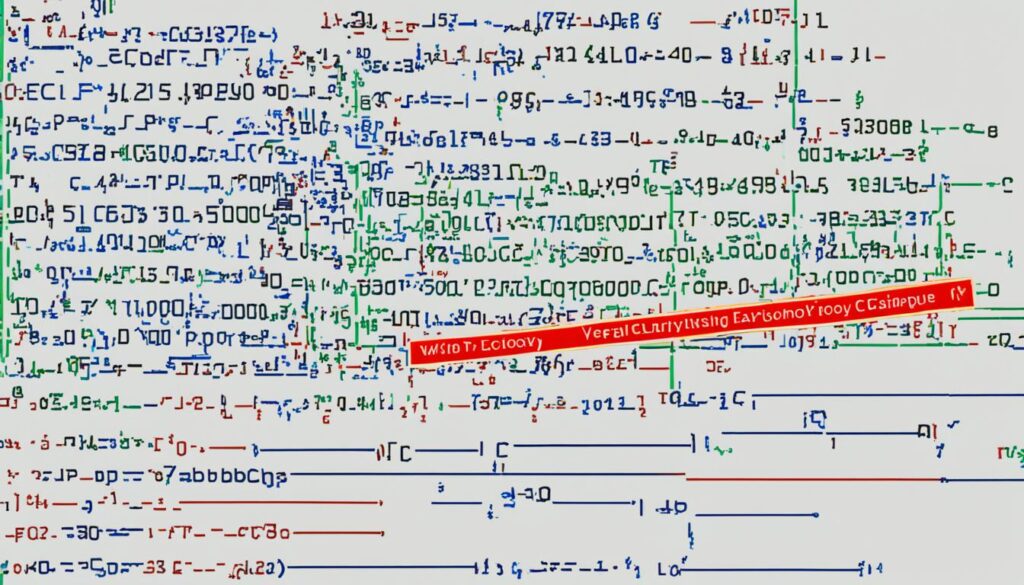In this section, we will explore the topic of number representation in Verilog, a hardware description language (HDL) commonly used in digital design and HDL coding. Understanding number representation is vital for effectively working with numbers in Verilog and optimizing digital designs.
When it comes to Verilog, numbers are represented using various techniques and strategies. These representations play a fundamental role in accurately conveying numerical values and performing mathematical operations within a digital design.
In this article, we will delve into the details of number representation in Verilog. By discussing concepts such as signed and unsigned numbers, binary, decimal, and hexadecimal representation, and even floating-point representation, we will equip you with the knowledge and skills required to efficiently manipulate numbers in Verilog code.
Whether you are a beginner or an experienced Verilog programmer, this article aims to provide valuable insights into the different number representation techniques used in Verilog. By mastering these techniques, you will be better prepared to tackle complex design challenges and create optimized Verilog code for your digital designs.
Table of Contents
Signed and Unsigned Numbers in Verilog
In Verilog, numbers are an essential component of hardware description language (HDL) coding for digital design. Two fundamental concepts that play a crucial role in number representation are signed and unsigned numbers. Understanding the differences and applications of these number types is integral to effectively implementing them in Verilog code.
Signed Numbers
Signed numbers are used to represent both positive and negative values. They are typically employed in scenarios where the magnitude and polarity of a value need to be considered. In Verilog, signed numbers are represented using the two’s complement notation. This means that the most significant bit (MSB) is used as the sign bit, with a value of 0 indicating a positive number and a value of 1 indicating a negative number. The remaining bits represent the magnitude of the number.
Unsigned Numbers
In contrast, unsigned numbers are used to represent only non-negative values. They do not have a sign bit and can only represent positive integers or zero. Unsigned numbers are widely used in applications where only positive values are relevant, such as counting or addressing.
Verilog provides specific data types for representing both signed and unsigned numbers. The most commonly used types are signed and unsigned. These data types allow for efficient manipulation and arithmetic operations on numbers using Verilog code.
Let’s now take a look at a table that summarizes the differences between signed and unsigned numbers:
| Property | Signed Numbers | Unsigned Numbers |
|---|---|---|
| Representation | Two’s complement | Positive integers or zero |
| Range | Covers both positive and negative values | Covers only non-negative values |
| Bit Width | Variable | Variable |
| Applications | Data processing, arithmetic operations, signed arithmetic | Counting, addressing, non-negative values |
Understanding the distinctions between signed and unsigned numbers is crucial in designing and implementing Verilog code for various applications. It enables precise handling of both positive and negative values, as well as optimization of hardware resources.
Now that we have explored the concepts of signed and unsigned numbers in Verilog, we can further broaden our understanding by diving into the different number systems commonly used in Verilog, such as binary, decimal, and hexadecimal representations.
Binary, Decimal, and Hexadecimal Representation
In Verilog, different number systems are commonly used for efficient representation and manipulation of data. The three main number systems are binary, decimal, and hexadecimal representation. Each system has its own advantages and disadvantages, making it crucial to understand their characteristics and how to convert between them.
Binary Representation
Binary representation is the fundamental number system in digital electronics and Verilog. It uses only two digits, 0 and 1, to represent numerical values. Each digit in a binary number is called a bit, and the position of the bit determines its weight. Verilog provides various operators and functions for performing arithmetic and logical operations on binary numbers, allowing for efficient processing and manipulation of digital data.
Decimal Representation
Decimal representation, also known as base 10, is the number system commonly used in everyday life. It uses ten digits, 0 to 9, to represent numerical values. Verilog allows for the representation and manipulation of decimal numbers using different data types and conversion functions. It is important to note that decimal numbers in Verilog are typically stored as binary values internally.
Hexadecimal Representation
Hexadecimal representation, or base 16, is frequently used in Verilog for its compactness and ease of use. It uses sixteen digits, 0 to 9 and A to F, to represent numerical values. Hexadecimal numbers are often used to specify memory addresses, register values, and bit patterns in Verilog code. Converting between binary and hexadecimal representation is straightforward, as each hexadecimal digit corresponds to a group of four binary bits.
Understanding binary, decimal, and hexadecimal representation is essential for working with digital data in Verilog. The ability to convert between these number systems allows for efficient coding and debugging in digital design. By leveraging the advantages of each representation, Verilog programmers can effectively implement complex digital systems and algorithms.

Floating-Point Representation in Verilog
Floating-point representation is a fundamental concept in Verilog for effectively handling decimal values. In this section, we will delve into the techniques and considerations involved in representing and manipulating floating-point numbers in Verilog.
Floating-point representation allows Verilog to accurately represent a wide range of real numbers, including those with fractional components. It is commonly used in applications that require precise calculations, such as scientific simulations, financial modeling, and signal processing.
One of the key advantages of floating-point representation is its ability to express numbers with varying magnitudes. Unlike fixed-point representation, where the position of the radix point is fixed, floating-point numbers utilize a dynamic format that adjusts based on the number being represented.
Verilog provides several predefined floating-point formats, such as single-precision (32-bit) and double-precision (64-bit), each with its own characteristics and precision levels. These formats follow the IEEE 754 standard, which specifies the representation and arithmetic operations for floating-point numbers in computer systems.
Floating-Point Components
When working with floating-point numbers in Verilog, it’s essential to understand the components of their representation. A floating-point value consists of three main parts:
- Sign: A single bit that represents the positive or negative sign of the number.
- Exponent: A group of bits that controls the magnitude of the number.
- Mantissa: Also known as the significand or fraction, this part contains the significant digits of the number.
The combination of these components allows Verilog to represent numbers within a specified range and precision. By adjusting the exponent and mantissa, the Verilog code can accurately express a broad spectrum of values, from very small to extremely large.
Floating-Point Arithmetic
Verilog provides built-in support for performing arithmetic operations on floating-point numbers. From basic addition and subtraction to more complex operations like multiplication and division, Verilog allows precise calculations while considering factors like rounding and error propagation.
However, it’s important to be mindful of the limitations and potential issues that can arise when working with floating-point arithmetic in Verilog. These include issues like precision loss, rounding errors, and the handling of special values like NaN (Not a Number) and infinity.
In order to mitigate these challenges, Verilog offers a range of techniques and best practices for optimizing floating-point computations, such as optimizing floating-point pipelines, reducing unnecessary precision, and employing efficient algorithms.
Example of Floating-Point Representation in Verilog
Let’s consider an example to illustrate floating-point representation in Verilog. Suppose we have the number 3.14, which we want to represent using single-precision floating-point format.

In the example above, the sign bit is 0 (positive), the exponent bits are 10000110 (134 in decimal), and the mantissa bits are 10010000000000000000000. By combining these components, we can accurately represent the number 3.14 in Verilog using the single-precision floating-point format.
By understanding and effectively utilizing floating-point representation in Verilog, you can optimize your code to handle decimal values with precision and accuracy. Whether you’re working on complex mathematical computations or real-world applications, mastering floating-point representation is essential for achieving reliable and efficient results.
Conclusion
Mastering number representation in Verilog is essential for efficient HDL coding and digital design. Understanding the various techniques, including signed and unsigned numbers, binary, decimal, hexadecimal representation, and floating-point representation, equips us to tackle complex design challenges and optimize our Verilog code.
By leveraging signed and unsigned numbers, we can accurately represent both positive and negative values in Verilog, ensuring precise calculations and accurate results. Additionally, using binary, decimal, and hexadecimal representation allows for flexibility and convenience when working with different number systems in our designs.
Furthermore, by implementing floating-point representation, we can effectively handle decimal values without losing significant precision. This is particularly important when dealing with real-world measurements or computations that require high accuracy.
As digital design continues to evolve and advance, a solid grasp of number representation in Verilog remains a fundamental skill. With a thorough understanding of these concepts, we can confidently navigate the intricacies of HDL coding, optimize our designs, and create innovative and robust solutions for a wide range of applications.

